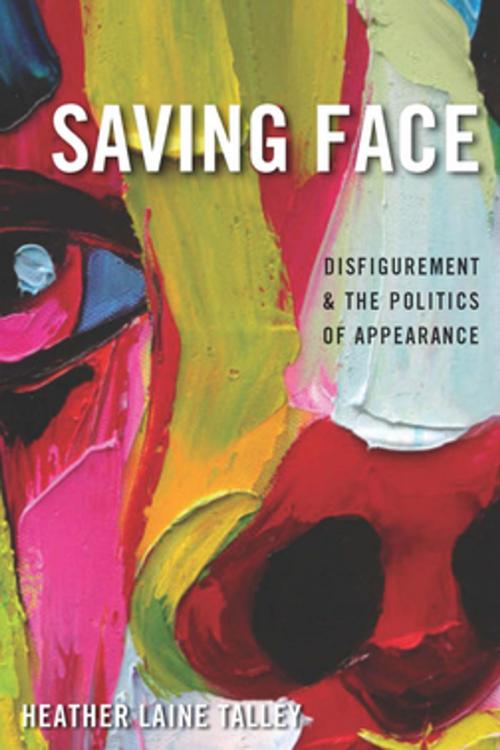Saving Face
Disfigurement and the Politics of Appearance
Nonfiction, Social & Cultural Studies, Social Science, Anthropology, Sociology| Author: | Heather Laine Talley | ISBN: | 9781479844982 |
| Publisher: | NYU Press | Publication: | August 15, 2014 |
| Imprint: | NYU Press | Language: | English |
| Author: | Heather Laine Talley |
| ISBN: | 9781479844982 |
| Publisher: | NYU Press |
| Publication: | August 15, 2014 |
| Imprint: | NYU Press |
| Language: | English |
Winner, Body and Embodiment Award presented by the American Sociological Association
Imagine yourself without a face—the task
seems impossible. The face is a core feature of our physical identity. Our face
is how others identify us and how we think of our ‘self’. Yet, human faces are
also functionally essential as mechanisms for communication and as a means of
eating, breathing, and seeing. For these reasons, facial disfigurement can
endanger our fundamental notions of self and identity or even be life threatening,
at worse. Precisely because it is so difficult to conceal our faces, the
disfigured face compromises appearance, status, and, perhaps, our very way of
being in the world.
In Saving Face, sociologist Heather Laine
Talley examines the cultural meaning and social significance of interventions
aimed at repairing faces defined as disfigured. Using ethnography,
participant-observation, content analysis, interviews, and autoethnography,
Talley explores four sites in which a range of faces are “repaired:” face
transplantation, facial feminization surgery, the reality show Extreme Makeover, and the international charitable
organization Operation Smile. Throughout, she considers how efforts focused on
repair sometimes intensify the stigma associated with disfigurement. Drawing
upon experiences volunteering at a camp for children with severe burns, Talley also
considers alternative interventions and everyday practices that both challenge
stigma and help those seen as disfigured negotiate outsider status.
Talley delves into the promise and
limits of facial surgery, continually examining how we might understand
appearance as a facet of privilege and a dimension of inequality. Ultimately,
she argues that facial work is not simply a conglomeration of reconstructive
techniques aimed at the human face, but rather, that appearance interventions
are increasingly treated as lifesaving work. Especially at a time when
aesthetic technologies carrying greater risk are emerging and when
discrimination based on appearance is rampant, this important book challenges
us to think critically about how we see the human face.
Winner, Body and Embodiment Award presented by the American Sociological Association
Imagine yourself without a face—the task
seems impossible. The face is a core feature of our physical identity. Our face
is how others identify us and how we think of our ‘self’. Yet, human faces are
also functionally essential as mechanisms for communication and as a means of
eating, breathing, and seeing. For these reasons, facial disfigurement can
endanger our fundamental notions of self and identity or even be life threatening,
at worse. Precisely because it is so difficult to conceal our faces, the
disfigured face compromises appearance, status, and, perhaps, our very way of
being in the world.
In Saving Face, sociologist Heather Laine
Talley examines the cultural meaning and social significance of interventions
aimed at repairing faces defined as disfigured. Using ethnography,
participant-observation, content analysis, interviews, and autoethnography,
Talley explores four sites in which a range of faces are “repaired:” face
transplantation, facial feminization surgery, the reality show Extreme Makeover, and the international charitable
organization Operation Smile. Throughout, she considers how efforts focused on
repair sometimes intensify the stigma associated with disfigurement. Drawing
upon experiences volunteering at a camp for children with severe burns, Talley also
considers alternative interventions and everyday practices that both challenge
stigma and help those seen as disfigured negotiate outsider status.
Talley delves into the promise and
limits of facial surgery, continually examining how we might understand
appearance as a facet of privilege and a dimension of inequality. Ultimately,
she argues that facial work is not simply a conglomeration of reconstructive
techniques aimed at the human face, but rather, that appearance interventions
are increasingly treated as lifesaving work. Especially at a time when
aesthetic technologies carrying greater risk are emerging and when
discrimination based on appearance is rampant, this important book challenges
us to think critically about how we see the human face.















